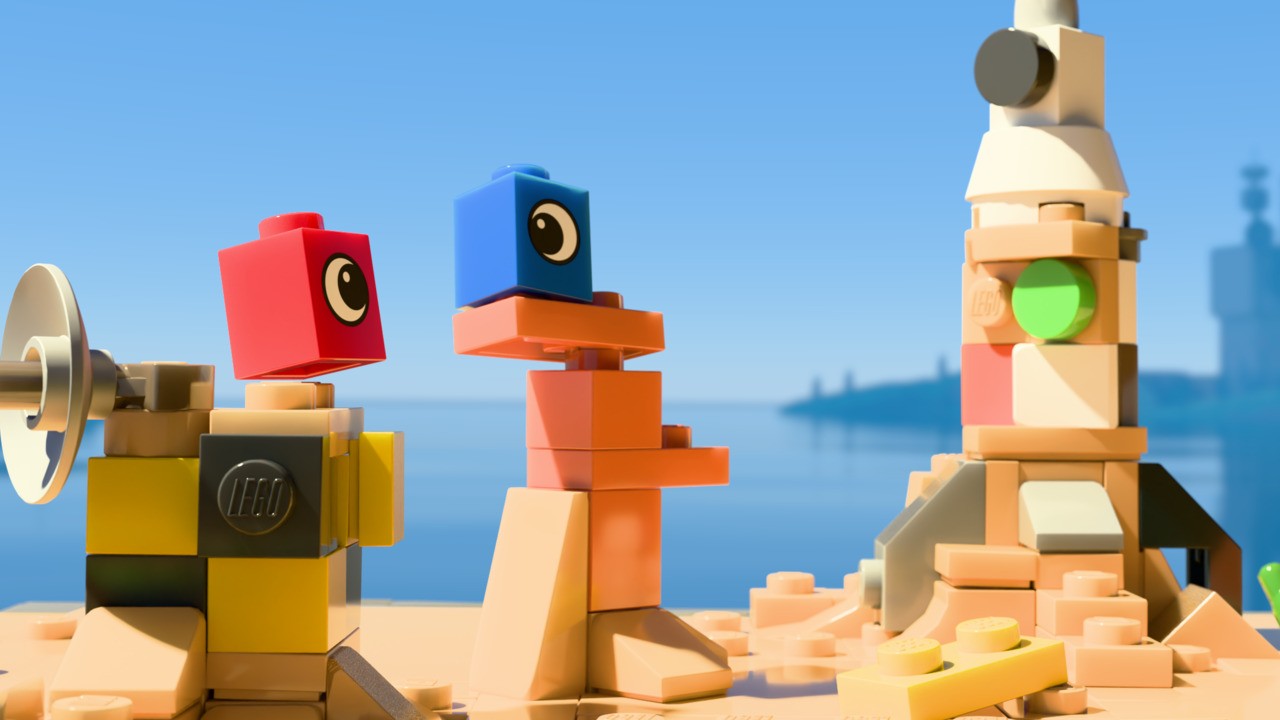
If you asked me what sort of game genre I think makes the best use of the Lego brick-building format, I’m not sure I’d answer with a two-player co-op adventure game. But here we are with LEGO Voyagers, a touching co-op title from Light Brick Studio (LEGO Builder’s Journey) that uses the brick-based gameplay to send you and another player on a small adventure.
Voyagers is a hybrid between a platformer and a puzzle game, utilising a very simple control scheme. You pilot either a red brick or a blue brick that live together on an idyllic little Lego island, and after a mishap nearby, the two bricks set out on an adventure that takes them to some strange and scary new places.
It’s strictly two-player co-op, so you can’t play this alone, but you can either tackle it online with someone or in couch co-op. The latter is how I played the game, over a couple of evenings with my fiancée. If one of you owns the game, a second player can also download a free Friend’s Pass, so that’s something to keep in mind.
Voyagers’ gameplay and tone are very charming, and it’s all helped along with a gorgeous art style, which especially shines on Switch 2. While the protagonist bricks have one emotive little eye, the world itself uses realistic lighting to make those plastic platforms look almost realistic, albeit made entirely of Lego. Adding to the whimsy of the two main bricks you control, you can press ‘Y’ at any time to make a little grunt or noise, and it’s always adorable.
Upon setting off on your adventure, it’s clear that Lego Voyagers feels a bit clumsy to control. Instead of simply running around, you must roll your individual bricks, with all of the resistance that rolling a cuboid against steps and other bricks brings. It’s often a mission in and of itself getting your little brick to the right spot, and while rolling them around is fun, this resistance occasionally gets tiresome, especially when trying to reach difficult platforms.
Thankfully, it’s not just platforming, however, as the game’s focus is on the different little islands or areas you encounter, and individual puzzles. Each chapter feels like its own diorama, and as you might expect from a Lego game, you and whoever you are playing with will be doing a lot of building.
Most puzzles involve you trying to get from A to B, and making either a bridge or some sort of steps to do so. It’s a concept that feels quite obvious, but is still really engaging. There’s just something so baseline enjoyable about putting Lego bricks together, especially when doing it with someone else.
To move bricks, you roll over to them and press ‘A’ to snap your red or blue brick onto them. Then, you roll over to your destination and press and hold ‘A’ again to assign a space for the other bricks. From this angle, you can quickly rotate bricks with ‘X’ and place them wherever you want.
This snapping onto bricks feels quite intuitive, and is essential to platforming as well, as later you must jump between ledges and use the snapping feature to move forward. It takes a while to understand, but it’s well executed. However, it doesn’t always feel as tight as it should, and occasionally my partner had to hand her controller to me, as she couldn’t quite nail exactly what the platforming sections demanded.
From here, there are a few different types of puzzles, or ways to extend the ‘bridge-building’ concept a bit further, but ultimately, the game only has around two or three solutions you’ll ever need to find. Even when other things are littered around, the game mostly focuses on building a bridge or steps. This feels a bit disappointing, as with a two-player co-op title, I want the chance to communicate with the other player and solve a larger puzzle together.
Quite often, Voyager devolved into realising we had to build a bridge, and my partner just watching me do it because I found it easier to control. One puzzle involved moving a boat around to gather batteries, and the mixture of both players having to move the boat, and figure out the smaller puzzles around the batteries was a highlight, but a high that was all too rare.
There’s an argument to be made that Lego Voyagers is a ‘vibes’ game, as between the gorgeous visuals and the beautifully propulsive synth-led soundtrack, you’re probably just meant to experience this game together and enjoy the ride. We certainly did enjoy the ride, but compared to the constant ingenious puzzle-solving and essential communication of titles like It Takes Two, Voyagers often left us silent, waiting for one person to do what clearly needed to be done.
Outside of the gameplay itself, the visual language of the game is often confusing, too. On the main menu, it is almost impossible to tell what option you’re picking, as the selected text just goes a slightly different shade of white. Then, in the game, there’s quite a lot of screen shake that made both of us occasionally feel unwell. And that extremely bright lighting gives an overly washed-out look, which also meant that often we found it really hard to tell either where our bricks were or which bricks we could use to move forward.
There is a really lovely game here, but before you spend £19.99/$24.99, be aware that this is around a four or five-hour game maximum, and two or three at minimum.



